Grow sunflowers for special events on your homestead. They are fast-growing annuals that screen imperfections and look stunning in bouquets, centerpieces, and as backdrops to wedding photos. The key to success is choosing the right sunflower variety for your purpose.
Sarah is getting married in August and has asked for a homegrown sunflower bouquet for her wedding day. She’s planning a farm wedding so not only will we need sunflowers for the bouquets, corsages, and boutonnières, but also for table centerpieces, decorating the wedding canopy, and sunflowers to beautify and screen areas on the farm and provide photo backdrops.
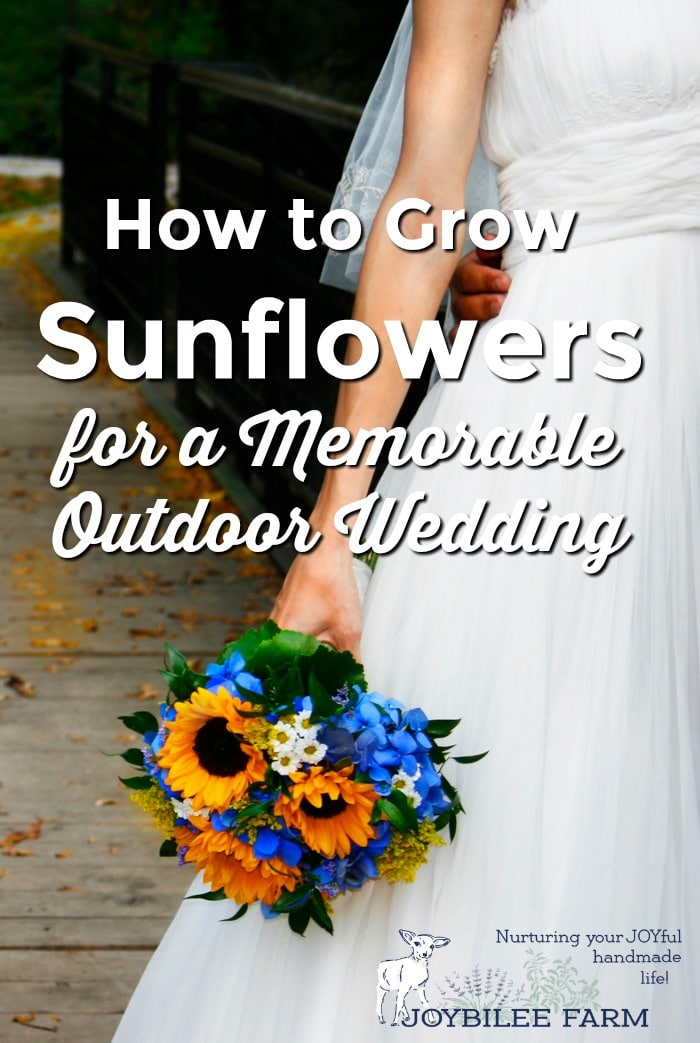
My quick calculation suggests we’ll need to grow sunflowers in huge numbers to meet the needs of this single memorable day. We’ll need to have 85 sunflowers, 75 secondary flowers like rudbeckia, bachelor buttons, or brown-eyed Susan, as well as 100 filler flower stems like baby’s breath, coreopsis, or statice to pull together all the flowers needed for an August wedding. We’ll also need large swaths of living, blooming, sunflowers for farm beautification, to screen the potholes, manure piles, and barns from public view and to provide beautiful photo backdrops around the farm.
It seems a huge task to make the farm pretty for visitors for a single day. However, sunflowers are fast growing, tall, and are the perfect flower for the task. And a wedding venue filled with homegrown, local flowers can’t be bought at any price, it can only be homegrown.
Advantages of Growing Sunflowers for a wedding
- Sunflowers are easy to grow.
- They germinate in just 7 to 14 days.
- They are annuals so they’ll bloom the same year that they are planted, even when grown in a short season area.
- There are varieties of sunflowers for every purpose, from fast-growing salad greens to wedding bouquets, snack food, and oilseed production. There are even perennial sunflowers that are grown for their starchy roots, like potatoes.
- The sunflower is completely non-toxic so there is no risk of being poisoned to pets, livestock, or grandchildren through accidental ingestion.
- Hybrid sunflowers bloom reliably on single stems, given the right growing conditions. There are short sunflowers that grow well in planters and at the front of garden beds. There are giant sunflowers that grow quickly and mask unsightly landscape features.
- Sunflowers are attractive to both native pollinators and honeybees. Even hybrid, pollenless varieties of sunflowers have nectar to attract pollinators to your garden.
- The hybrid pollenless varieties of sunflowers are perfect for our bouquets, centerpieces, and wedding flowers. They were developed for the cut flower market, so they have the traits we need for wedding flowers. These sunflowers are made for bouquets and table settings. They won’t smear the bride’s white dress with pollen nor mess up the tablecloths at the wedding. They’ll behave well during the wedding photos too.
Which varieties of sunflowers are the best to plant for a wedding?
Convinced that sunflowers were the ideal flower for our farm wedding needs I started looking through the seed catalogs and ordered a half a dozen sunflower varieties to plant for the wedding based on color and flower shape. This is where I made my first mistake.
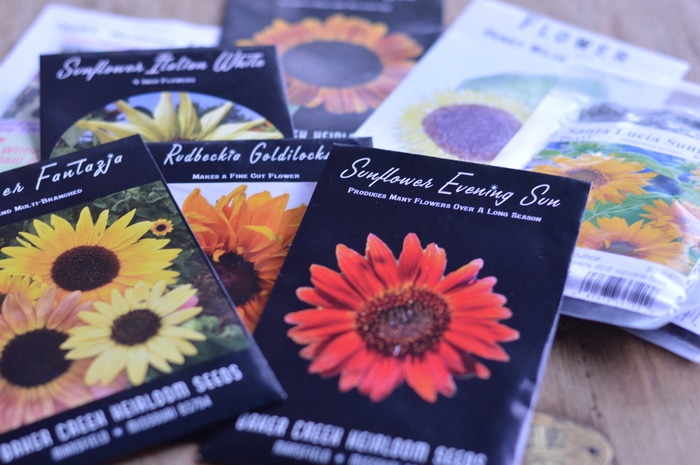
The seeds I bought from Baker Creek Seed and William Dam Seeds didn’t have the information I needed to make wise choices. And my seed choices weren’t the best. In fact, I may have made a big mistake and possibly wasted my money.
The heritage seed I bought from Baker Creek, while it was a quality open-pollinated seed, probably won’t ever bloom in my short season zone 3 gardens. I wasn’t able to find out the time from planting to bloom time on the package nor on their website, so it will be a gamble to get flowers from Italian White, Fantazja, Evening Sun, Red Sun, and Henry Wilde sunflowers, in my short season garden.
Update: I heard back from Fred Perlee at Bakercreek Seeds. Here’s what he said for bloom times:
- Italian White — 75 to 90 days
- Red Sun — 85 to 95 days
- Evening Sun — 95 to 105 days
- Henry Wilde — 100 days
- Fantazja — 100 days in my garden

I also bought a large mixed package of cutting flower sunflower seed from William Dam that didn’t have any varieties named on the package. I won’t know till I plant it and grow it out, whether we’ll have blooms in August for the wedding. The package says germinates in 5 to 10 days and blooms in 8 to 12 weeks. 55 to 85 days is a large time span. That tells me there’s a chance for blooms in August if I plant in mid-May. But it’s hard to say if it will give us flowers at the right stage of development at the right time with that big of a time frame. Especially in our cool, mountain soil.
However, since these are branching sunflowers once the flowers begin to bloom they should continue blooming till the frost in early September. That’s some benefit. I won’t rely on this for bouquet stems but it will hopefully grow enough by August to provide a living screen for farm beautification and photo backdrops.
None of my usual sources for seed were very helpful for planning for Sarah’s sunflower wedding since the seed packages didn’t give specific information about “days to bloom”. This sent me back to doing more research. It seemed like it just might be impossible to figure out which sunflower varieties would give me blooms at the right time. To figure this out I needed information that wasn’t available on the seed packages. This was a formidable problem.
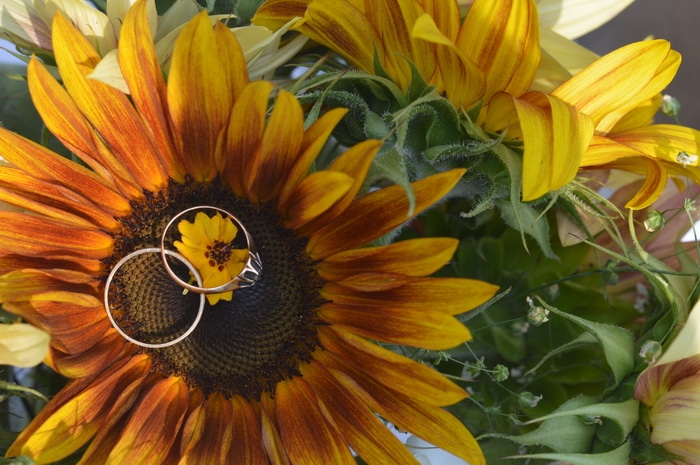
When to plant sunflowers to get blooms in August
I realized as I researched this question that I not only needed to know which varieties to plant to get blooms in August, my first obstacle, I also needed to know when to plant the seed. I needed to know when to plant sunflowers to be sure of having blooming flowers in time for the wedding, but not too soon that the blooms would be done before we needed them. Unlike vegetable seed packages, sunflower seed packages don’t tell you the number of days to bloom time on the package. I thought initially, no problem, I’ll just look it up on the internet.
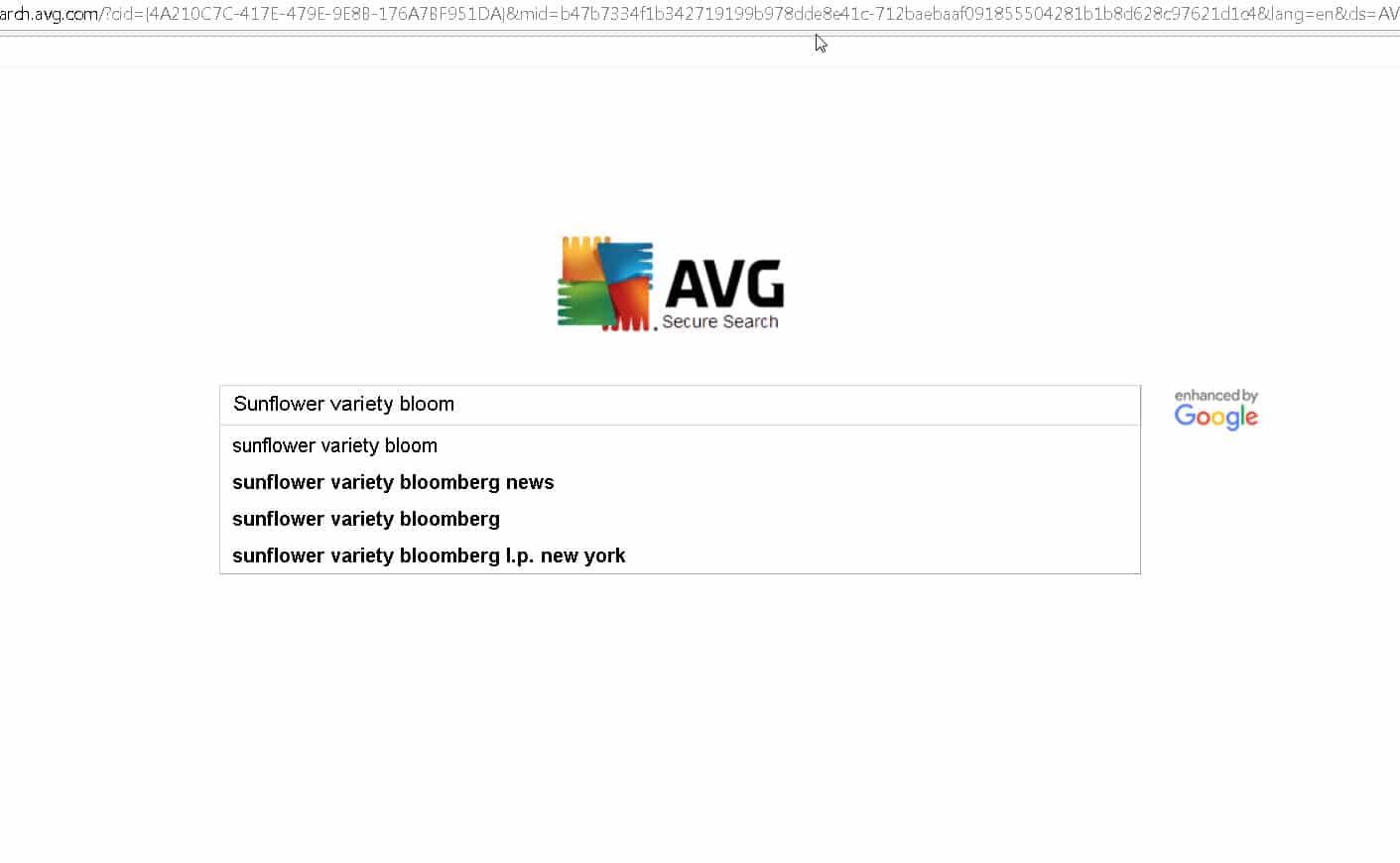
I found out though, that sunflowers follow a fairly predictable life cycle and that helped.
The lifecycle of a sunflower
With my short frost-free season of only 75 or so days, I normally start tender annuals indoors. But while sunflowers can be started ahead of time in pots, you don’t gain much time. For many varieties of sunflowers, starting in pots so stunts their growth that they never recover fully. Further, sunflowers started indoors aren’t as stable as sunflowers planted directly where they will grow. They grow so fast that they can become root bound in the starter pot and then would need staking outside. Sunflowers don’t transplant well.
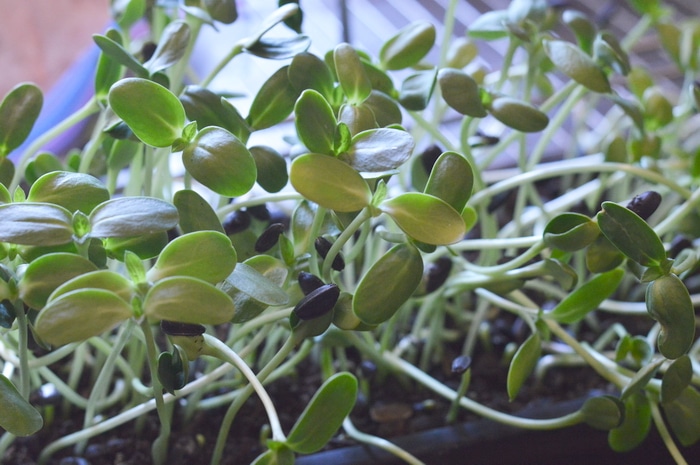
Sunflowers take 5 to 14 days to germinate. It helps to soak the seed overnight before planting to soften the shell. Then keep the soil evenly moist while the seedling emerges. You can even eat sunflowers as sprouts at this stage of growth.
Once the germination takes place, the sunflower sprouts come through the soil and form two seed leaves. Within a week the true leaves emerge. Growth continues rapidly with the growth of both stem and leaves. About 30 days later the first flower buds begin to form at the top of the plant.
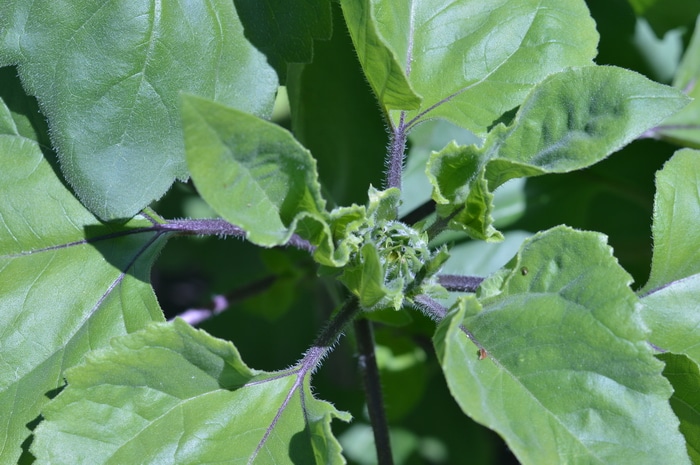
It can take 3 weeks or more for the flower bud to develop into a flower.
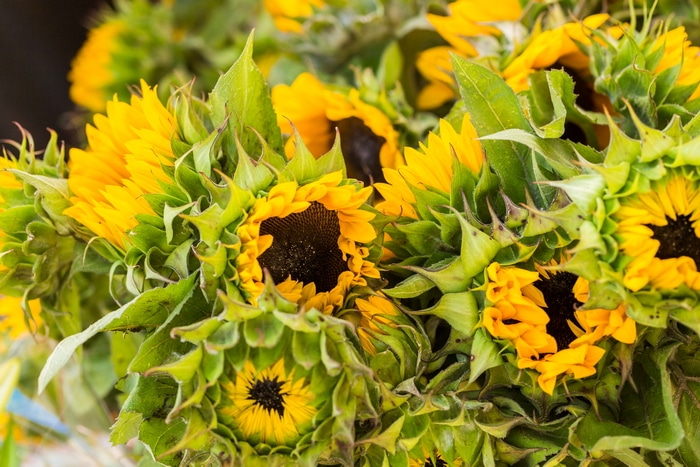
Sunflowers are a heliotropic species, which means that immature sunflowers in the bud stage will track the sun from east to west during the day and will return to face the east during the night.
Over the course of the following week, the sunflower’s petals begin to unfurl, gradually opening to a ray disk. For cut flowers, the flower stems should be harvested when the petals are at right angles to the center disk, like the central flower in the picture above. This makes the total time from planting to flowering about 70 to 75 days on average.
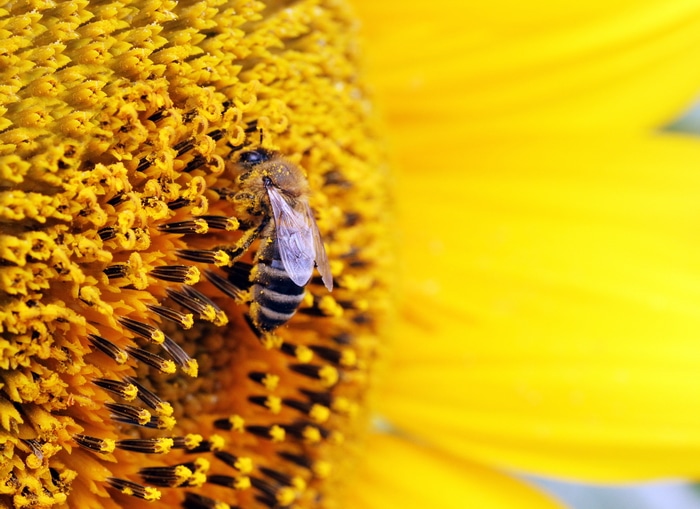
Disk florets bloom across the center of the sunflower. Bees pollinate the disk florets which leads to seed development. After only a week the petals drop off. The flower stops tracking the sun and droops down on the stalk. On branching sunflowers, the flower heads continue to develop at the end of branches, prolonging bloom time. These secondary flowers are generally smaller than the central flower. Branching sunflowers will continue to produce new flowers on branching stalks until frost. The branching flowering stalks would give us a second chance at smaller flowers for centerpieces and bouquets if we missed the ideal time on the first flowers.
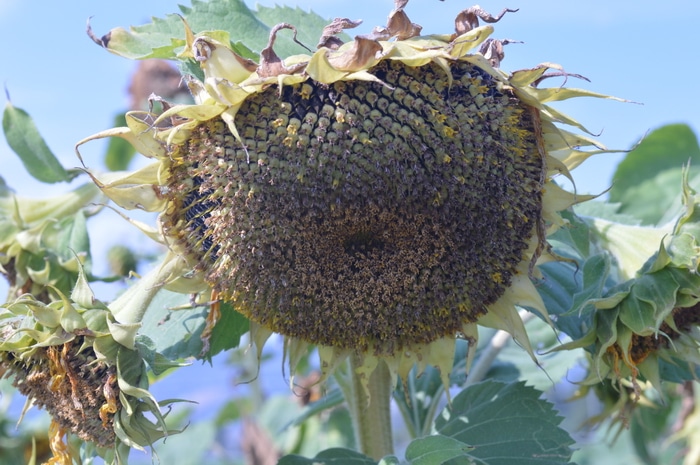
After flowering, it takes an additional 30 days for the seeds to mature. The seeds swell. The florets dry and naturally fall to the ground. As the seeds mature the sunflower wanes, yellows, and drops its leaves. The plants will die when the nighttime temperatures drop to 28°F.
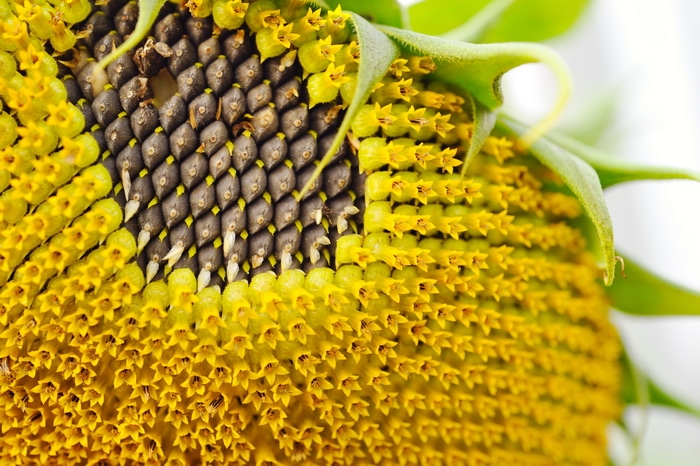
This information told me that in general, I could expect flowers ready for cutting around 70 days after planting. So if I could plant seeds by June 1 on the farm I should have sunflowers in bloom on the day of the wedding.
However, this general information didn’t tell me what I could expect for the specific varieties of sunflowers we’d need for the bouquet. The bouquet flowers need a little more exact science than “around 70 days after planting” if we will have flowers in the optimal condition for the bride’s and bride’s maids’ bouquets and the table centerpieces.
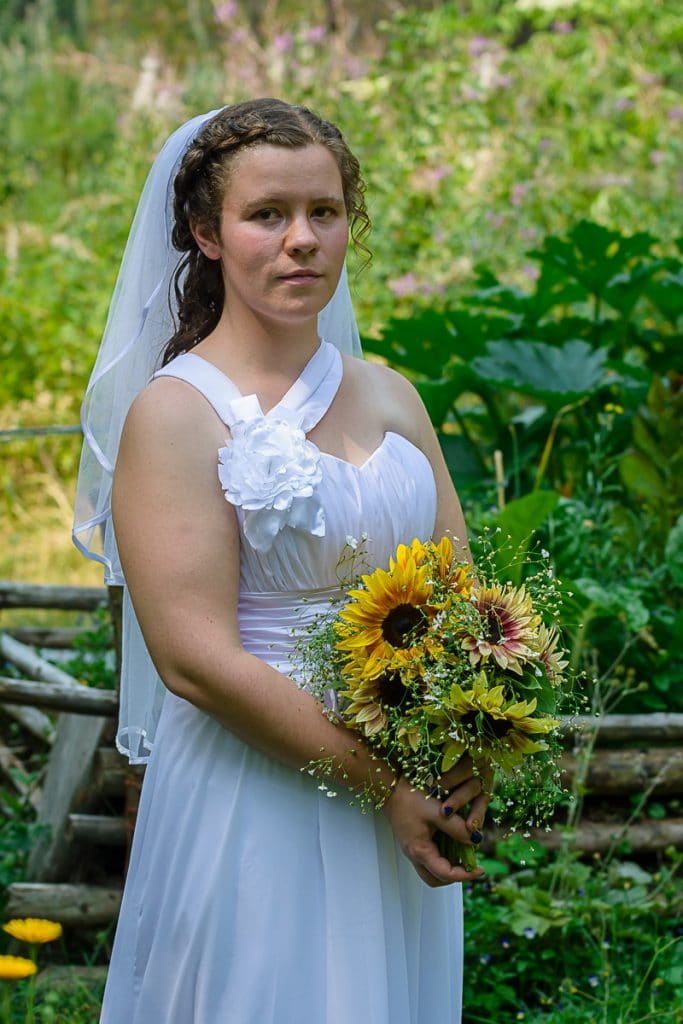
Photo used with permission Sheryl McIver of Mobetta Photography, Grand Forks, BC
Should I start to grow sunflowers indoors or direct seed?
I reached out to the folks at Wildseed Farm in Fredericksburg, Texas and asked their advice on how to grow sunflowers, so that I could be sure of fresh sunflowers for the wedding.
Wildseed Farms grows wildflower seeds, including sunflower. They are the largest wildflower working farm in the USA. They know a thing or two about growing flowers. Back in April, we visited their farm with our friends Amy and Adrienne. We picked up a few packages of different sunflower seeds to plant for the wedding, including Chocolate Cherry, a deep red sunflower that grows to 6 feet tall, and Santa Lucia Sunflower, that grows only 2 to 3 feet tall.
Kay Kiler, from the Wildseed Farm, suggested that sunflowers take 7 to 14 days to germinate if the ground is kept moist. Then 60 to 75 more days to bloom and an additional 7 days to fully open the flower head on the stalk. Counting backward from the wedding date brings the best time to plant the sunflower seeds as 70 to 80 days before the wedding, and again 2 weeks later or May 15; June 1; and June 15.
This agrees with the lifecycle of a sunflower I found in my research but doesn’t tell me how an individual sunflower variety will perform. The variety seed package from William Dam Seed indicated there can be more than a month difference between the varieties of sunflowers in just that one package.
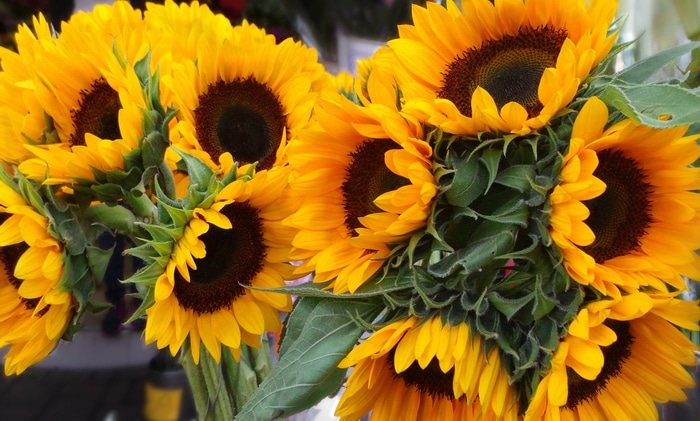
Different sunflower varieties and their days to bloom time
My research led me to Johnny Select Seed, where I found a couple of handy charts that gave me sunflower bloom times for a few of the sunflower varieties that Johnny’s carries. Since sunflower varieties vary in the number of days from planting to bloom time, it’s important to choose sunflower varieties for the wedding that have a predictable growth pattern and a shorter time to bloom, due to our shorter growing season.

With the goal of planting the sunflowers at the end of May or beginning of June to give open flowers in the second week of August, I made a short list of varieties that would help us reach our goals. Here’s a handy chart focused on those sunflower varieties that will bloom in 50 to 75 days from planting. I included a few heritage varieties from Baker Creek Seed that are much longer so that you can see how important it is to choose sunflowers for a wedding based on the length of days from planting to bloom time.
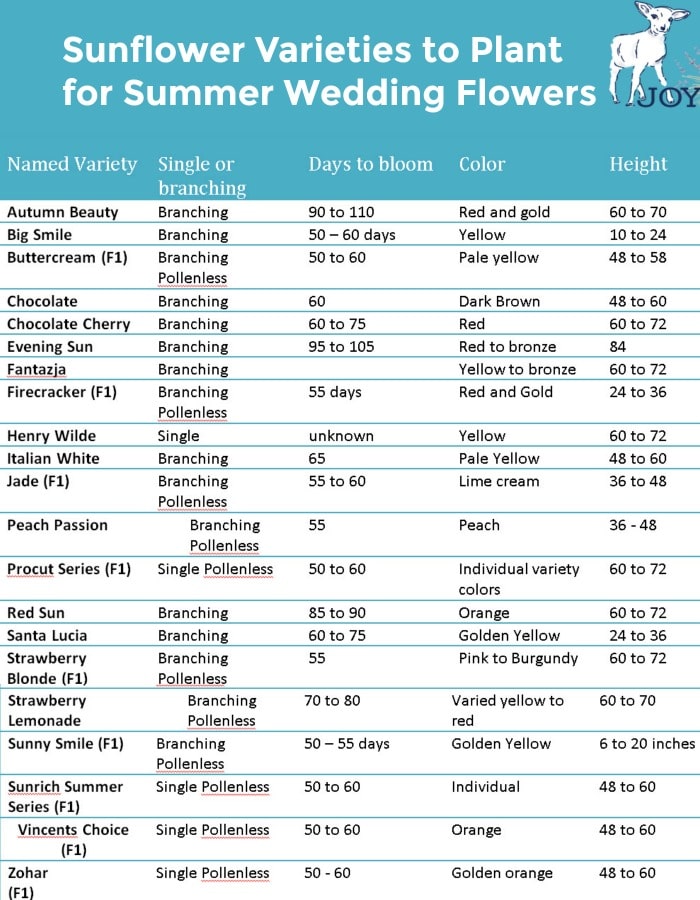
Even within the individual sunflower varieties, the actual bloom times will vary depending on the seasonal weather patterns, how much heat we have during the growing season and moisture levels where we plant them. By planting several different varieties we have a better chance of getting some blooms in time for the wedding, but just in case we’ll need a back-up plan, for peace of mind. Our short season garden can be unpredictable.
Lemon Queen is THE Sunflower variety for the Great Sunflower Project, a project designed to survey pollinators in your backyard and gather data on a national scale. But Lemon Queen won’t flower for me before frost. Lemon Queen is a branching sunflower that flowers 90 days after planting. Something to consider if you planned on doing this project with your kids during the summer.
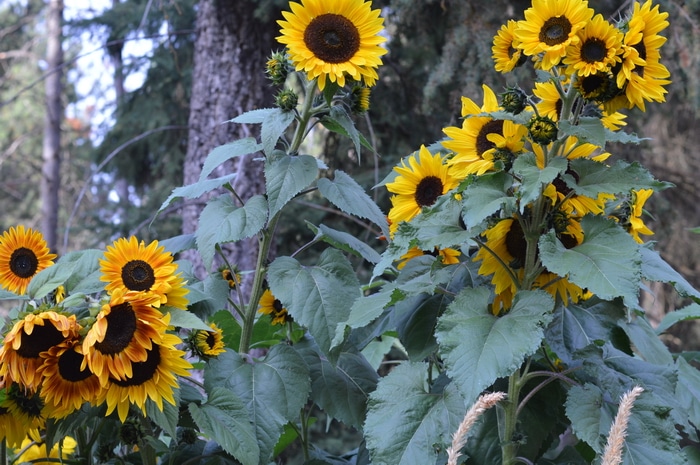
The sunflower varieties I chose to grow this summer
I wanted to grow sunflowers that would meet several different purposes on the farm. I wanted them for decorations, privacy screens, photo backdrops, and beautification. I might even create a sunflower fort for my granddaughters to play in for the wedding reception. I’ll need smaller sunflowers in containers for the decorations so they can be moved around the farm as needed during the wedding day. I’ll also need tall branching sunflowers to screen areas of the farm and to be photo backdrops.
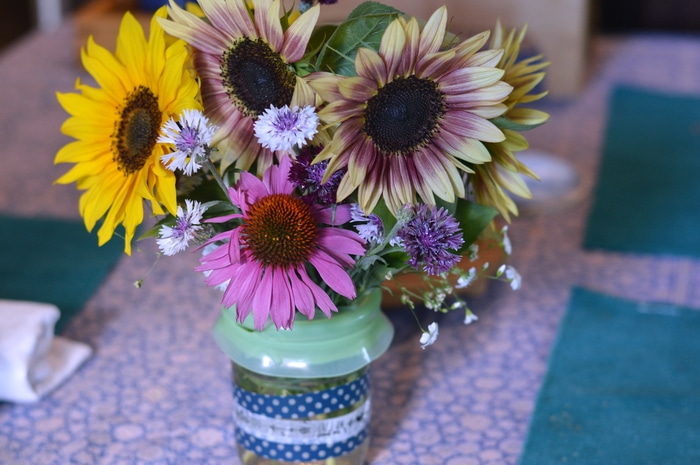
Miniature sunflower varieties for decorations and wedding favors
I settled on “Sunny Smile” sunflower to grow compact sunflowers in 6-inch pots for wedding favors and decorations around the farm. Sunny Smile, from Johnny Select Seeds, is a miniature sunflower with a 2 to 5-inch bloom that grows only 6 to 10 inches high if planted in a pot but will grow 20 inches high if grown in the ground. It’s a branching sunflower that blooms in just 50 days from planting. I’ll be able to plant in mid-June with ample time to grow sunflowers for wedding favors. These compact containers can be moved around the farm for wedding decor and then be handed out as favors to guests as they leave.

Tall branching sunflower varieties for screens and photo backdrops
I chose several taller varieties with branching habits to grow sunflowers for screening areas of the farm to make them look prettier and more inviting.
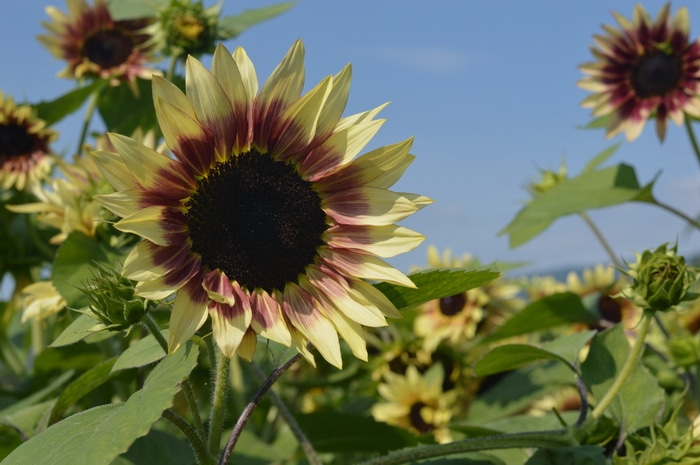
Strawberry Blonde sunflower is a lemon-yellow and pink variegated sunflower that grows 5 to 6 feet tall and has a branching habit. The first blossoms will appear in just 55 days from planting. With Strawberry Blondes branching habit we’ll have blooms till frost from a June 10th planting, so we can plant this one after our last frost date.
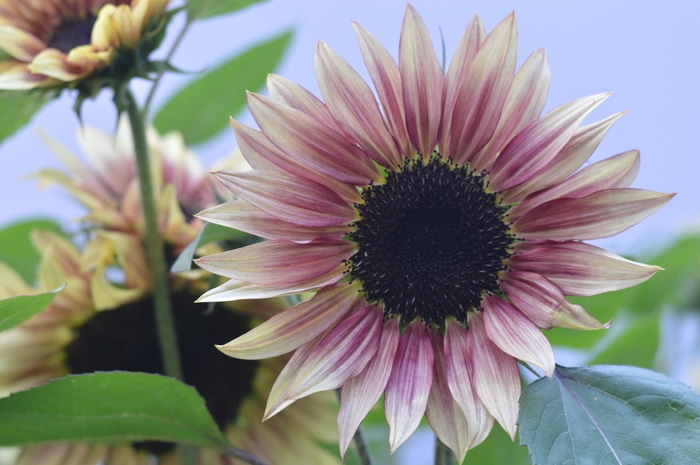
Strawberry Lemonade sunflower is another mixed sunflower that has both pink and yellow blooms. It’s a tall branching sunflower but with a longer window from planting to bloom time. Strawberry Lemonade will make a lovely screen around the farm. I’ll be planting it with Strawberry Blonde but about 2 to 3 weeks sooner. This will give a succession of blooms that will continue to open till heavy frost.
I’ll grow the other sunflowers that I bought to serve as screens and decorations around the farm but I’ll plant them early, in the middle of May and put them under a row cover for the first 4 weeks to protect them from frost. The seeds won’t go to waste.
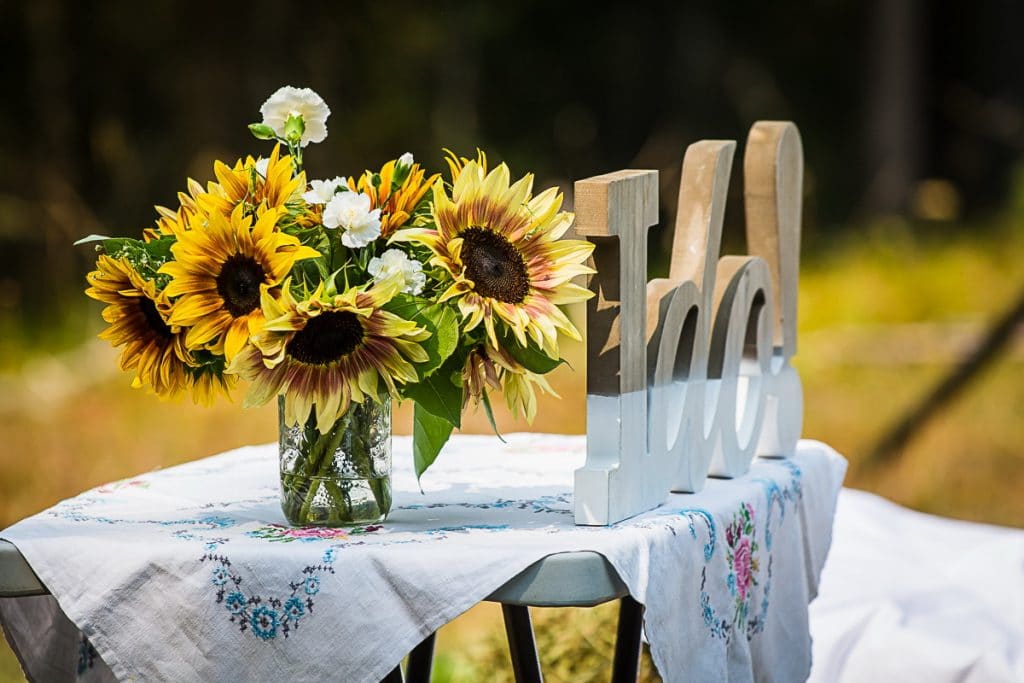
Photo used with permission Sheryl McIver of Mobetta Photography, Grand Forks, BC
Grow sunflowers for bouquets and arrangements
To ensure that I have prime blooms for the bouquets and arrangements I’ll plant these varieties on a succession planting schedule beginning at the end of May and planting sunflower seeds every 2 weeks. The sunflowers for the bouquets are single stem varieties and will be planted 4 to 6 inches apart to ensure smaller stems. Plant all sunflowers in full sun.
Zohar Sunflower is a single stem, pollenless sunflower with fast growth. Zohar blooms in just 50 days from planting on 4-foot stems. It is pollenless and single so we’ll only get one chance to get the right planting date. I’ll start planting Zohar on June 1st and I’ll plant 1oo seeds every week till the 3rd week of June. This way I should have blooms at the right stage for the wedding flowers in August.
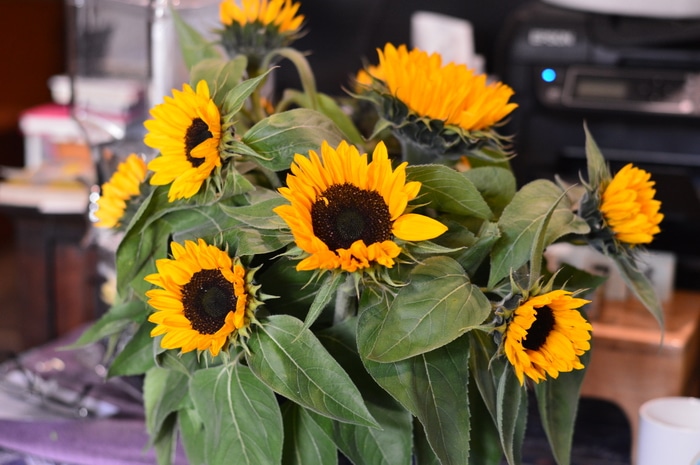
Zohar Sunflowers
Sunrich Orange Summer is another single stem, pollenless sunflower that grows from 4 to 5 feet. It blooms in 50 to 60 days and has the same 4 to 6-inch blooms that Zohar has. I’ll plant this one using the same staggered planting schedule that I’m going to use for Zohair. Together Zohair and Sunrich Orange Summer will look stunning in table arrangements.
Santa Lucia Sunflower is an open pollinated sunflower with 3 to 4-inch blooms and a branching habit. It is only 3 feet tall. I’ll need to plant them May 15 and again on June 1st to get blooms in August for the wedding. The plants will keep producing till frost. I’ll plant these in the same area as the hybrid sunflowers.
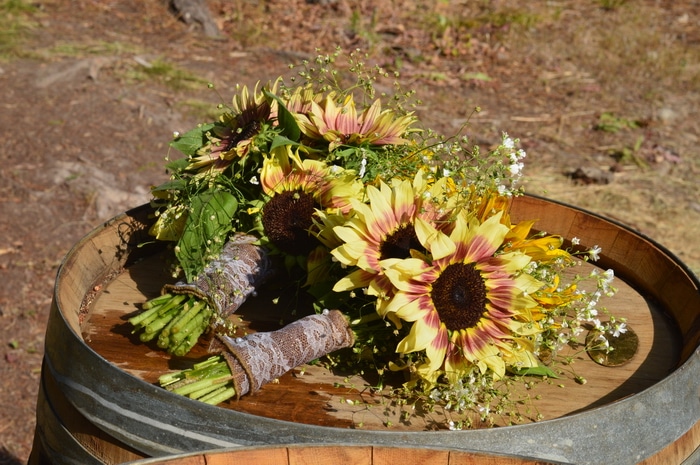
Other flowers will also be needed to round out the bouquets and flower arrangements for the August wedding. Thankfully some of those are already growing in my garden. Perennial echinacea looks stunning beside sunflowers in the vase. Bachelor buttons keep blooming until frost, as well.
In addition, I’ll be adding a few more rows of flowers to my herb garden to make sure I have enough blooms. And just in case we have a disaster just before the wedding we have a backup plan.
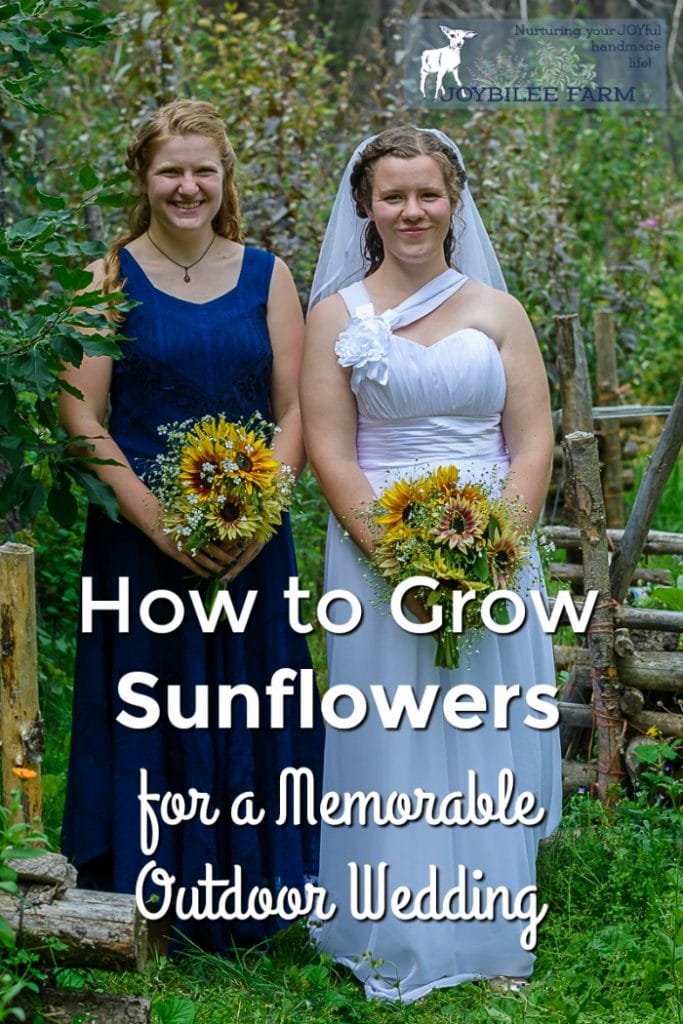
Used with permission. Mobetta Photography, Grand Forks, BC
Update:
The wedding in August was fabulous. The weather was perfect. Although my sunflowers were just beginning to bloom, my friend in the town just a few miles away had sunflowers in full bloom. We harvested all that we could and had ample blooms for table centerpieces, bouquets, and table settings. My neighbor, Sue, came over and helped me create the lovely bouquets for the bride and her bride’s maid. The sunflowers that were just beginning to bloom at Joybilee Farm offered a lovely backdrop for photos. The wedding could NOT have been more beautiful. And at the end of the day I gained a son-in-law. And that’s, after all, the most important part, isn’t it?
We continued to harvest blooms from the sunflower plantings well into October. The native pollinators especially appreciated the ample blooms over the long blooming season from the end of July to the end of October. Most of the varieties we planted were branching sunflowers and they didn’t fail us. They were not affected by frost and in fact, it seemed like a couple of the varieties performed better after they had a nip of frost.
I’ll definitely create larger plantings of sunflowers in the coming years both for the native pollinators and for bouquets.
Your turn:
Have you ever attended an outdoor wedding? What was memorable about it for you?



This article is both very informative and filled with so much love. Thank you so much for every word. The sunflower is my absolute favorite! I just bought my first house and hope to plant beautiful sunflowers every year!! Thank you so much for your help. I would love to see photos from the special day!!!
Your article is great, I have more information and experience to grow sunflowers in my garden garden. And the sunflower garden will become the most beautiful when blooming
Chris, Just a little tip. For Sarah’s hand bouquet if you used (artifical) very life like sunflowers she could keep it as a keepsake of her special day.
Debbie
PS Good luck on the sunflower growing I’m keeping my fingers crossed.
Thank you, awesome article. I read every word. I’ve never included any sunflowers in my garden before, I will now! And I’ll be successful thanks to you!! May the special day be as lovely as the thought put in it! Can’t wait for the big day pictures!! Have an amazing day!!